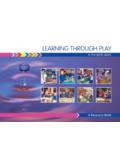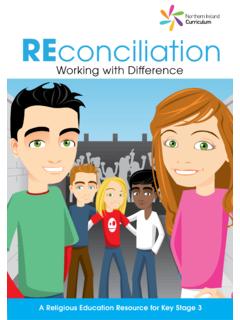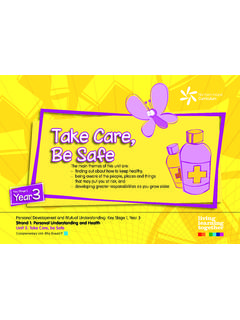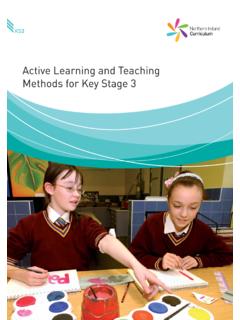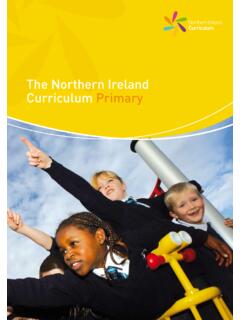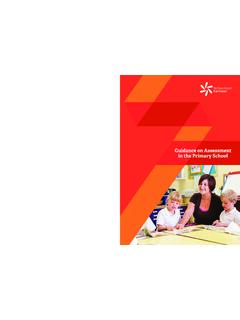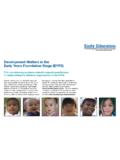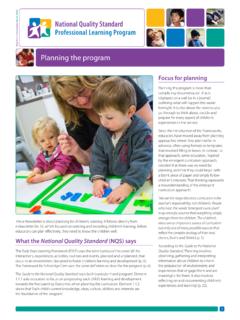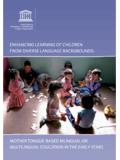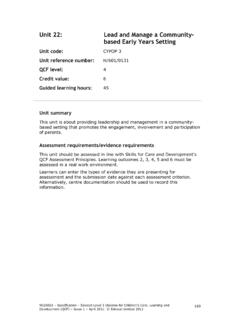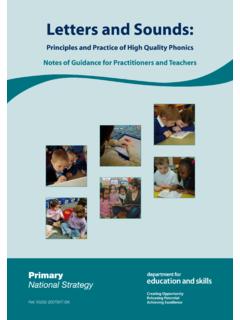Transcription of (PDF) Thinking Skills in the Early Years - Curriculum …
1 Thinking Skills in the Early Years : A Guide for Practitioners G Walsh, P Murphy and C Dunbar in collaboration with the EYEcep team Correspondence: Glenda Walsh Stranmillis University College Stranmillis Road BELFAST BT9 5DY Tel: 02890 384 432 Fax: 02890 664 423 Email: Skills in theEarly Years : A Guide for Practitioners 1 ACKNOWLEDGEMENTS The authors wish to thank the sponsors from the Northern Ireland Council for Curriculum , Assessment and Examinations (CCEA). Our greatest debt of gratitude is owed to the teachers, principals and above all the children who combined so agreeably to make the study a most interesting and enjoyable experience and, without whom, the project would not have been the success it Skills in theEarly Years : A Guide for Practitioners 2 EXECUTIVE SUMMARY Thinking Skills and Personal Capabilities is an integral feature of the Foundation Stage Curriculum (CCEA, 2007), which is to become a requirement in all year 1 classrooms from September 2007 and in all year 2 classrooms in the subsequent school year .
2 This report was commissioned by the CCEA to provide teachers and practitioners with some practical guidance about how Thinking Skills can be enhanced in an Early Years classroom and how to assess whether young children are Thinking in a constructive way. The report is based on two sources: a survey of key literature on the development of Thinking Skills in young children and in depth classroom observations (taken over a period of two consecutive days) conducted in four year 1 classrooms identified as offering a high quality learning experience as part of the Enriched Curriculum Pilot Project (Sproule et al. 2005). Using the evidence from the literature base as well as best examples from classroom practice, the findings were analysed according to: the adults role the physical environment and the children s actions in terms of how Thinking Skills can be effectively promoted in Early Years classrooms.
3 Key Findings The key findings are outlined below: Teaching strategies identified as promoting young children s Thinking Skills fall into four phases: Tuning in phase: the adult observes, listens, encourages and shows sensitivity to the children before deciding to intervene in their play or practical activities Development phase: the adult uses modelling, scaffolding or questioning strategies to extend the Thinking experience Thinking Skills in theEarly Years : A Guide for Practitioners 3 Creative phase: the adult provides open ended and practical tasks for the children and encourages them to think beyond the routine, emphasising the importance of completing an activity with flair and imagination and Reflective phase: the adult encourages the children to reflect on their experiences, introducing perhaps a degree of ambiguity into the children s thought processes to allow challenge to take place.
4 A high quality Thinking environment is considered to: be physically attractive children s work attractively displayed colourful and spacious outdoor facilities used effectively have a positive ethos in place friendly home like encouraging supportive welcoming involve a Curriculum which is play based, practical, challenging, flexible and open ended. Assessing children s Thinking is much more than assessing their cognitive ability. A summary of the literature, supported by the case studies, suggests that to fully support the development of children s Thinking we need to pay attention to the following six key areas: Social/emotional development Are children adequately confident to tackle ambiguity and express their point of view? Motivation and dispositions to learn Do children show adequate persistence to stay with a problem and to think it through? Thinking Skills in theEarly Years : A Guide for Practitioners 4 Cognitive development Have children developed the capacity to sequence and order, classify and sort at a concrete level?
5 Linguistic development Have children acquired the linguistic competence to explain and give reasons? Can they explain why they have done things in a certain way, discuss their plan of action and answer open ended questions? Creative development Do children show a degree of imagination and flair in what they do? Reflective responses Can children ask questions and express the need to find out more? Can children be to some extent self critical, accept suggestions from others, tackle ambiguity and be open to challenge? Thinking Skills in theEarly Years : A Guide for Practitioners 5 CONTENTS Acknowledgements 2 Executive Summary 3 Table of Contents Introduction Methods Literature Review Introduction The Adult s Role in the Powerful Thinking Environment Collaborative Thinking Creative Thinking Reflective Thinking Summary of Adult s Role The Role of the Environment Summary of the Role of the Environment The Role of the Children in the Thinking Experience Summary of the Children s Role Evidence from the Observations Introduction Background to the Setting Evidence from the Case Studies: Teaching Strategies Sensitivity The Use of Thinking Language The Use of Questioning Modelling Strategies Scaffolding Creative Learning Experiences Reflection Evidence from the Case Studies.
6 The Learning Environment Colourful and Stimulating Children s Own Work in Evidence Learning/ Thinking Aids on Display Outdoor Facilities Ethos Practical and Play Based The Observation Instrument Concluding Comments Recommendations Appendices ReferencesThinking Skills in theEarly Years : A Guide for Practitioners 6 INTRODUCTION The Curriculum , Examinations and Assessment Authority (CCEA) commissioned this literature review on Thinking Skills to inform the implementation of the revised Northern Ireland Curriculumin Foundation Stage classes. One of their key goals is to ensure that the Early Years of schooling in Northern Ireland should become less formal in nature, offering instead a more developmentally appropriate, child led and Skills based approach to teaching and learning. As CCEA (2007) states, Young children learn best when learning is interactive, practical and enjoyable for both children and teachers ( ).
7 A key aspect of the revised Northern Ireland Curriculum is the emphasis placed on the development of key Skills , in particular Thinking Skills . As CCEA (2007) states, In order to develop children s Skills and capabilities across the whole Curriculum , teachers will need to provide frequent opportunities for pupils to think and do for themselves (pg. 10). This move to encourage better Thinking in our Early Years classrooms comes at a time when society, with its emphasis on the knowledge economy, demands individuals to be able to process effectively and organise and retrieve information. Problem solving capabilities are also particularly desirable. This shift means that the acquisition of Thinking Skills has become a major educational objective in recent Years . According to Trickey and Topping (2004), curricular prescriptions in a number of countries have shown decreased emphasis on content knowledge and increased emphasis on transferable Skills such as critical and creative Thinking , as is the case in the revised Northern Ireland Curriculum .
8 According to McGuinness (1999), there are several general taxonomies of Thinking available. Drawing on the work of Swartz and Parks (1994), McGuinness offers examples of an array of different kinds of Thinking such as: sequencing and ordering information sorting, classifying and grouping analysing, identifying part/whole relationships and comparing and contrasting making predictions and hypothesising Thinking Skills in theEarly Years : A Guide for Practitioners 7 drawing conclusions and giving reasons for conclusions distinguishing fact from opinion determining bias and checking the reliability of evidence generating new ideas and brainstorming relating cause and effect and designing a fair test defining and clarifying problems, Thinking up different solutions and setting goals and sub goals testing solutions and evaluating outcomes planning and monitoring progress towards a goal and revising plans and making decisions, setting priorities and weighing up pros and cons.
9 McGuinness argues that what is included and excluded can be arbitrary and dependent on the age group, the degree of challenge and the context/subject matter being taught. Much of the literature on Thinking Skills tends to focus on older children in upper primary and secondary schools (Higgins et al. 2004). The apparent gap has recently been filled with Taggart et al's (2005) literature review of Thinking Skills in the Early Years . Nevertheless, Venville (2002) points out that much of the existing literature addresses the need for Thinking Skills to be fostered but little attention is actually given as to how such an objective can actually be achieved. The need to provide Early Years teachers with practical advice on how a high quality Thinking environment can be both activated and assessed formed the key aim of this study. The intention within this report therefore is not to undertake another review of how children think (see Taggart et al.)
10 2005) and the different theoretical approaches to developing Thinking (see McGuinness, 1999), but rather to provide teachers with a practical toolkit for enhancing and assessing Thinking Skills in an Early Years classroom, based on an infusion methodology in which Thinking pervades all of the Early Years Skills in theEarly Years : A Guide for Practitioners 8 Objectives Our remit for this review was two fold: (1) The first objective was to examine the existing literature on Thinking Skills in an attempt to identify what constitutes a high quality Thinking environment froman Early Years perspective. This involved a literature survey of good practice in the pedagogy of Thinking Skills in the Early Years , supported by in depth observations in a small number of Early Years settings identified as offering a high quality learning environment as part of the Enriched Curriculum Project in Northern Ireland (see Sproule et al.

